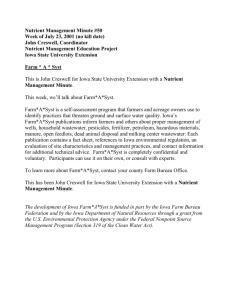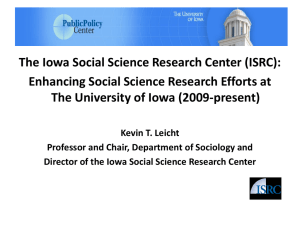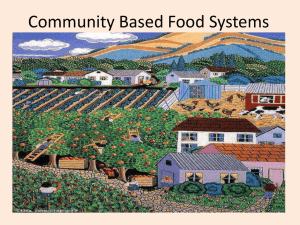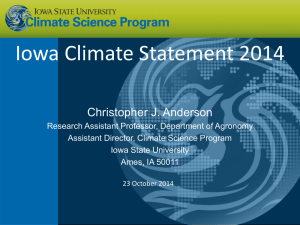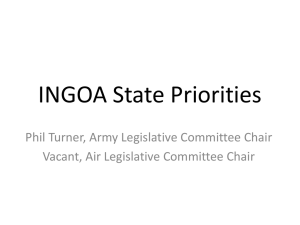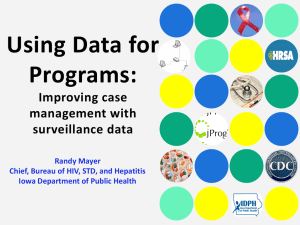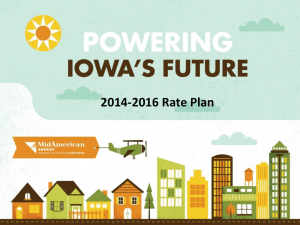Organic Presentation - Iowa State University Extension and Outreach
advertisement
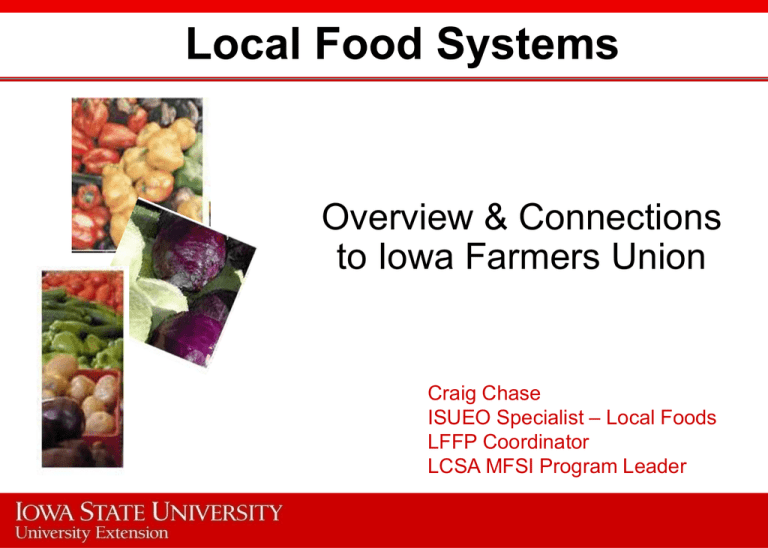
Local Food Systems Overview & Connections to Iowa Farmers Union Craig Chase ISUEO Specialist – Local Foods LFFP Coordinator LCSA MFSI Program Leader Local Food System Quiz 1. It is estimated that Iowans spend how many $billion on food each year? a) $2 b) $4 c) $6 d) $8 2. What percent of local food purchased is produced in Iowa? a) 2% b) 6% c) 10% d) 14% Local Food System Quiz 3. If Iowans ate and purchased locally 5 servings of fruit and vegetables per day for 3 months, how much would it add to the Iowa economy? a) $165M b) $212M c) $287M d) $302M 4. How many jobs would it add to the Iowa economy? a) 1,015 b) 2,752 c) 3,687 d) 4,094 Local Food System Quiz 5. Iowa has how many of the following: a. Farmers’ Markets? (96,164, 196, 226) b. CSA farms? (14 , 26, 41, 52) c. Buy Fresh, Buy Local chapters? (3,6,8,11) d. Farm to School chapters? (2, 4, 7, 9) e. Regional Food System Working Groups? (4, 7, 13, 16) f. Organizations, non-profits, etc. that serve as local food resources (50, 65, 75, over 85) Why Local? Problem #1 • Who is going to farm and what are the opportunities for a beginning farmer to begin to farm? • Can most beginning farmers make a living with a conventional C-Sb farming operation given… – Current land prices – Current machinery prices? • What are the expectations that a beginning CSb conventional farmer can be large enough to make a living? Percent of Iowa Farmers Over 65 and Under 35 Years Old 30% 25% 20% 15% 10% 5% 0% 1959 1964 1969 1974 1978 < 35 1982 1987 > 65 1992 1997 2002 2007 Farms and Sales by Sales Class in Iowa, 2007 50% 45% 40% 35% 30% 25% 20% 15% 10% 5% 0% Less than $1,000 to $2,500 to $5,000 to $10,000 to $25,000 to $50,000 to $100,000 $250,000 $500,000 $1,000,000 $1,000 $2,499 $4,999 $9,999 $24,999 $49,999 $99,999 to to to or more $249,999 $499,999 $999,999 Farms Sales Local Food Systems Benefits • Opportunity #1 – the capital costs for beginning farmers is much less due to smaller machinery and land base needed. – Fruit and vegetable operations, along with niche livestock offer an opportunity for beginning farmers that want to farm, to be able to farm with less risk and less capital outlay. Problem #2 • With fewer farms surrounding small rural communities, there becomes fewer kids in school and fewer consumers to purchase local merchandise resulting in declining small rural communities. • Declining communities lead to fewer opportunities for non-farm kids to remain in the communities they grew up in. Local Food Systems Benefits • Opportunity #2 – Development of local food systems contributes jobs to the Iowa economy. – According to Dave Swenson at ISU, if all Iowans purchased locally 5 servings of fruits and vegetables for 3 months, $302 million in economic activity would accrue along with the creation of 4,094 jobs. – According to a recent USDA study, for every $1M in local produce sales, 13 FTE on-farm jobs are created. Problem #3 • There is changes occurring to the global climate resulting in wider swings in temperatures and weather events (droughts, floods, etc.) due to increases in greenhouse gases. • Non-renewable energy supplies are decreasing and prices are more sensitive to supply swings. Local Food Systems Benefits • Opportunity #3 – Local food systems offers the potential to lower greenhouse gases and fuel usage through a more regional distribution system than the global system that is currently in place. Problem #4 • Health… Local Food Systems Benefits • Opportunity #4 - Promote healthier eating habits – (pull in obesity… etc.). Why Now? Local Food Systems Interest • Interest is increasing rapidly because of the benefits of local food system development • (insert a story about Food and Fitness or other; review their annual reports… the story should focus on the why the need for local food) Local Food Systems Interest • (insert another story –). Response to increased interest... Response from Iowa State University • The Leopold Center along with the College of Agriculture and Life Sciences entered into a 3yr agreement in the summer of 2010. • Agreement enabled Ajay Nair and Joe Hannan (horticulturalists) to be hired and Craig Chase (farm management) to be reassigned. • Purpose – increase research and outreach related to fruits and vegetable production and profitability. Response from Iowa State University • In September 2010 ISU Extension and Outreach began the following: – Develop an Extension-wide Plan of Work. – Inventory activities and aggregate outcomes related to food system work. – Obtain grant dollars to develop in-service training for all ISU employees. – Develop interdisciplinary teams to increase likelihood of receiving larger grants (e.g., Sustainable Food Systems to Improve Food Security). Response from the LCSA • Marketing Food Systems Initiative. – 16 Regional Food System Working Groups covering 83 counties in Iowa. – Support for various other working groups (grassbased livestock, pork-niche, energy,…). – Grant funding – approximately $200K new funding per year (6-7 new grants). – Development of resources (Growers manual, Learning about Local, etc.). Leopold Center for Sustainable Agriculture • Enhance Networks and Partners – Practical Farmers of Iowa • Young and beginning farmers is a growth area; most farmers are producing food. – Iowa Food System Council • Diverse group of individuals and organizations focused on finding common ground and developing partnerships to address food system issues. – Iowa Innovation Council • Food is one of their targeted economic development areas. Leopold Center for Sustainable Agriculture • Networks and Partners – Sysco of Iowa – working with Primus and others regarding GAPs training and audits. – Hy-Vee – working on GAPs training and other barriers for producers. – Luther College, ISU Dining, UNI Dining, and others – working on barriers for food to institution. – Malcolm Price, Independence, … and others – working on barriers for farm to school. Leopold Center for Sustainable Agriculture • Networks and Partners – GROWN Locally – working on GAPs training, food hub development, producer manuals. – Resource Conservation and Development (RC&D) districts. Many of these have local food coordinators. – In total over 85 organizations and individuals are working on local food projects (Learning About Local). Response from the Legislature • Iowa Local Food and Farm Plan was a response to increasing consumer demand for local food. – Requested by Iowa legislature in 2010, presented in January 2011. – 29 operational recommendations / six sections: • • • • • • Business development and financial assistance Processing Food safety Beginning, minority, and transitioning farmers Assessing progress Local food incentives. Response from the Legislature • Local Food and Farm Initiative passed legislation (based on Plan). • Initiated Coordinator and Advisory Council. • Preliminary report due February 2012, final report due June 2012. • 5 section leaders to assess progress, identify barriers, and outline next steps for each recommendation. • Identify projects to fund based on section leader findings and recommendations. Response from the Iowa Farmers Union • Supportive of the Iowa Local Food and Farm Plan and the new Local Food and Farm Initiative. • NOTE: That support from organizations like IFU is why this legislation passed and the Food Plan work can progress in Iowa. Local Food and Farm Program • Initiated Coordinator and Advisory Council. • Preliminary report due February 2012, final report due June 2012. • 5 section leaders to assess progress, identify barriers, and outline next steps for each recommendation. • Identify projects to fund based on section leader findings and recommendations. Progress – Based on ILFFP • Business development and financial assistance – Implementation of 4-6 food business projects • Food hub, shared-use kitchen, other ideas – Iowa Small Business Loan Program extension – Local food development training for lenders • Processing – Expanding education for small meat processors Progress • Food Safety – Offering recurring GAP training. – Offering food safety audit cost-share program. – Food regulations publication is underway. – Producer manual for post-harvest handling is completed. – Producer was added to Iowa Department of Inspections and Appeals Food Safety Task Force Progress • Beginning, minority, transitioning farmers – Surveys are underway to determine the number of organizations working in this area and programs currently being offered. – Initial findings indicate a wide range of programs, but limited programming related to optimizing labor and farmers working together to aggregate supply. Progress • Assessing progress – Different organizations and grant programs are seeking consistency with measuring local food purchases and sales. – Data base development for identification of producers and purchasers is being studied. Progress • Local food incentives – Farm to school programs are being identified, new pilot programs are being sought. – Farm to institution programs are being identified, new pilot programs are being sought. • Keep in mind that the section team has been in place for a little over a month. Further progress will be made over the next 60 days. Next Steps… • From regional and national studies, it appears: – The largest barrier is likely to be expanding production and aggregation; second largest is likely to be food safety. – Other areas of expanding opportunities include working with beginning, minority, and transitioning farmers and urban agriculture. Next Steps… • BOTTOM LINE The pace and the breadth of what happens next is dependent upon financial commitments by the legislature and other interested parties. Questions….. Any questions or comments? Thank You for This Opportunity! Craig A. Chase Leopold Center for Sustainable Agriculture Marketing and Food System Initiative Program Leader Iowa State University Extension and Outreach Local Food and Farm Program Coordinator Local Food Systems and Alternative Enterprise Analysis 209B Curtiss Hall Ames, IA 50014 (515) 294-1854 cchase@iastate.edu
